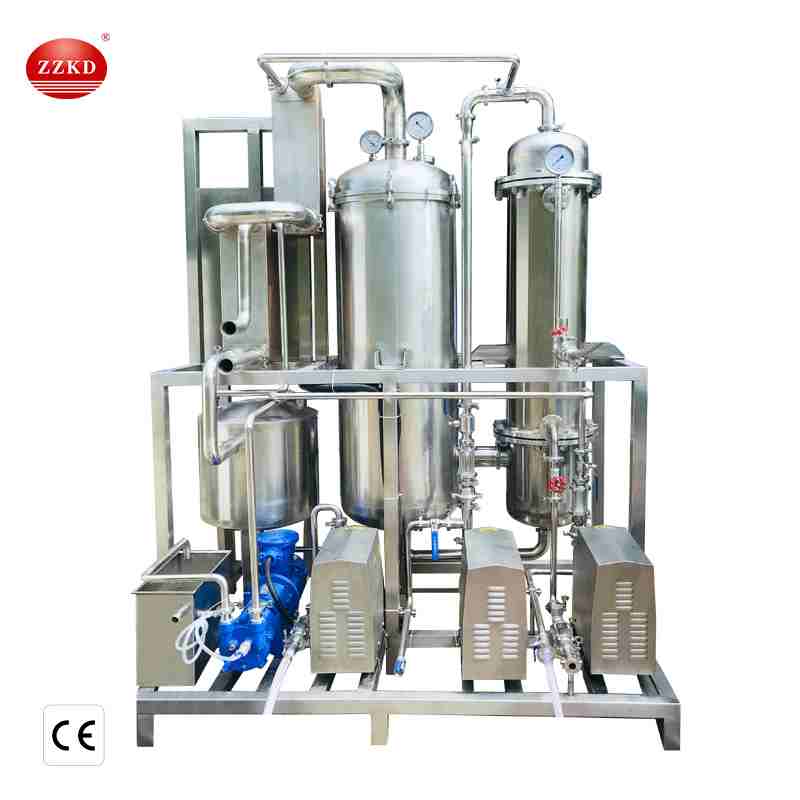Falling film evaporator working principle
Falling film evaporator is a kind of high-efficiency single-pass non-circulating film evaporation equipment. Its evaporation principle sets the falling film evaporator to have high heat transfer efficiency, small temperature difference loss, short heating time, not easy to deteriorate, easy to multi-effect operation, and energy. Low consumption, small equipment size, etc., are widely used in evaporation operations in chemical, pharmaceutical, light industry, food, petrochemical, and metallurgical industries.

The falling film evaporator system is composed of various effect evaporators, various effect separators, condensers, heat pumps, sterilizers, insulation pipes, vacuum and drainage systems, various effect material liquid transfer pumps, sub-cylinders, operating platforms, electrical instruments Control cabinet, valve, pipeline, etc.
The working principle of the falling film evaporator is by adding the material liquid from the upper tube box of the heating chamber of the falling film evaporator, and the liquid is evenly distributed into the heat exchange tubes through the distribution and film forming device. Under the action of gravity, vacuum induction and air flow, Flow from top to bottom into a uniform film. During the flow process, the liquid is heated and vaporized by the heating medium in the shell side, and the generated vapor and liquid phase enter the separation chamber of the evaporator together. After the vapor and liquid are fully separated, the vapor enters the condenser for condensation (single-effect operation) or enters the next-effect evaporator As a heating medium, so as to achieve multi-effect operation, the liquid phase is discharged from the separation chamber. Falling film evaporation is to add the material liquid from the upper tube box of the heating chamber of the falling film evaporator, and distribute it evenly into the heat exchange tubes through the liquid distribution and film forming device. Under the action of gravity, vacuum induction and air flow, it becomes a uniform film. Flow from top to bottom. During the flow process, it is heated and vaporized by the heating medium in the shell side. The generated steam and liquid phase enter the separation chamber of the evaporator together. After the vapor and liquid are fully separated, the steam enters the condenser for condensation (single-effect operation) or enters the next-effect evaporator as The medium is heated to achieve multi-effect operation, and the liquid phase is discharged from the separation chamber.
The process flow has four forms: cocurrent (parallel flow), countercurrent, mixed flow (cross flow), and advection:
Downstream:
The solution and steam flow in the same direction, and both flow sequentially from the first effect to the last effect. The raw material liquid is pumped into the first effect, depending on the pressure difference between the effects, it automatically flows into the next effect, and the finished liquid is pumped out of the last effect (usually operating under negative pressure). Because the pressure of the latter effect is low, the boiling point of the solution is also low. When the solution enters the latter effect from the former effect, it will flash part of the water and generate more secondary steam. Because the concentration of the latter effect is higher than that of the former effect and the operating temperature is lower , Often the heat transfer coefficient of the first effect is much higher than that of the final effect. The downstream process is generally suitable for processing materials that are heat sensitive at high concentrations.
countercurrent:
The raw material is sent from the last effect to the front effect by the pump, the finished liquid is discharged by the first effect, and the material liquid and the steam flow in reverse. Generally, it is suitable to handle solutions whose viscosity changes greatly with temperature and concentration, and it is not easy to handle heat-sensitive materials.
Mixed flow:
It is a combination of forward and backward flow processes, and has the advantages of forward and backward flow to avoid its shortcomings, but the operation is complicated and requires a high degree of self-control.
advection:
Each effect is filled with materials to produce a finished liquid, and each effect has crystals, which can separate the crystals in time, and is generally used for the evaporation of saturated solutions.


